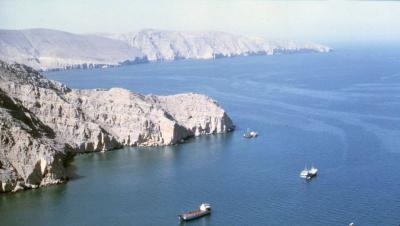The Strait of Hormuz, the main waterway located at the entrance to the Arabian Gulf, remains a focal point of global concern, continuously monitored in anticipation of potential disruptions that could affect the maritime route through which about 30% of global oil trade passes. Recent Iranian threats of retaliation against Israel—blamed for the death of Hamas leader Ismail Haniyeh in Tehran—have raised new fears regarding the safety of navigation in this strategic passage, according to Bloomberg.
Over the years, Iran has frequently targeted commercial vessels passing through this strait and has repeatedly threatened to close it. Although Tehran did not issue explicit threats this time to disrupt navigation in Hormuz, its support for the Houthis, who are launching maritime attacks in the Red Sea, may indicate its willingness to disrupt global shipping in pursuit of its goals, the agency suggests.
**Location and Strategic Significance**
The Strait of Hormuz is shaped like an inverted "V," connecting the Persian Gulf to the Indian Ocean. Iran is located to the north of the strait, while the United Arab Emirates and Oman are to the south. The strait extends approximately 161 kilometers, narrowing to about 34 kilometers at its narrowest point, with navigational passages in both directions not exceeding 3.2 kilometers in width. Its shallow depth makes crossing vessels susceptible to naval mines, and its proximity to the coasts—especially the Iranian coast—places ships within reach of land-based missiles, making them easy targets for patrol boats and helicopters.
The strait's importance lies in being a vital artery for global trade, particularly oil. Oil tankers transported nearly 15.5 million barrels per day of crude oil and condensates from Saudi Arabia, Iraq, Kuwait, the UAE, and Iran through it during the first quarter of 2024, according to Bloomberg statistics. The strait is also a key route for liquefied natural gas, with over a fifth of global supplies, mostly from Qatar, passing through during the same period.
**A History of Tensions**
Iran has long utilized tactics to harass ships in the Gulf, either to express its dissatisfaction with imposed sanctions or as a pressure tactic in international disputes. Despite repeated threats, Iran has not yet fully closed the strait. Analysts believe it is unlikely that Iran would completely shutter the strait, as this would hinder its ability to export oil. Additionally, its naval capabilities do not match those of the US Fifth Fleet and other forces in the region.
Protecting navigation in the strait has garnered global attention for a long time. During the "Tanker War" between Iraq and Iran in the 1980s, the US Navy escorted ships through the Gulf. In 2019, the United States launched "Operation Sentinel" in response to Iranian threats, involving the participation of ten other countries, which is now known as the "International Maritime Security Initiative."
Recently, much of the focus has shifted to protecting shipping in the southern Red Sea and the Bab el-Mandeb Strait amid increasing attacks by Iranian-backed Houthis on vessels in that area. The United States currently leads a naval force in the Red Sea to safeguard navigation there.
**Potential Impact on the Global Economy**
Saudi Arabia is the largest oil exporter through the Strait of Hormuz, although it seeks to diversify its export routes through a pipeline linking its oil fields to a port on the Red Sea. The UAE also has an alternative option to export some of its oil via a pipeline to the port of Fujairah on the Gulf of Oman. However, Iraq, Kuwait, Qatar, and Bahrain rely entirely on the strait for their oil exports.
Most of the oil passing through the Strait of Hormuz goes to Asia, meaning its closure would have less impact on Western nations that support Israel. Nevertheless, Bloomberg emphasizes that any disruption in this vital passage could significantly affect global energy markets and international supply chains.




